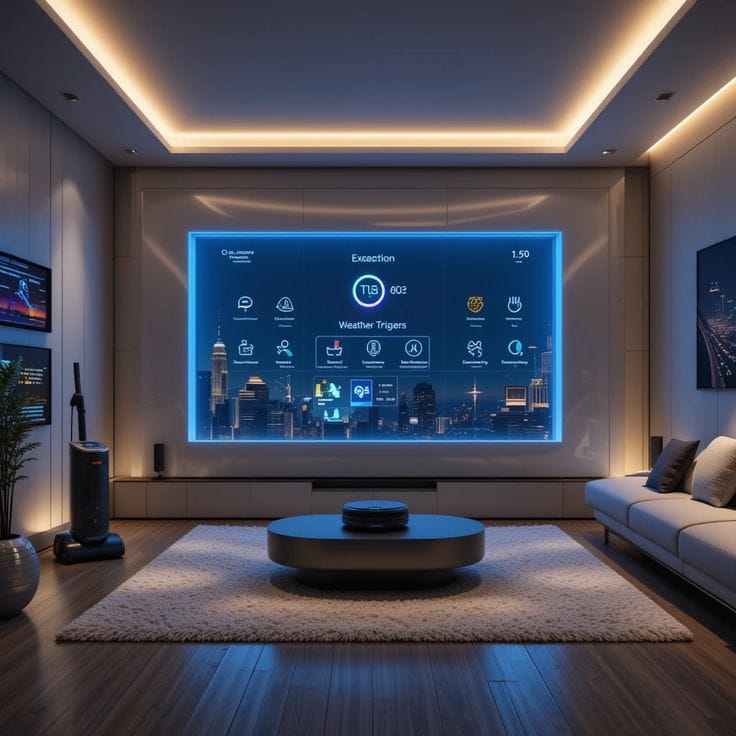As cities modernize and sustainability becomes a top priority, smart building management systems have emerged as powerful digital solutions to optimize building performance, improve energy efficiency, and enhance occupant comfort. These systems use a range of building technologies such as IoT sensors, centralized control platforms, and AI-powered analytics to streamline operations across lighting, HVAC systems, ventilation, and more. By integrating advanced IoT networks, smart buildings are transforming how facility systems operate in real time and based on occupancy.
What is a Smart Building Management System?
A smart building management system (SBMS) is an integrated digital platform that automates and centralizes the control of multiple building functions including lighting, HVAC, security, and energy usage. By connecting sensors and devices across a building, it enables smarter decisions through real-time monitoring and data analytics.
Understanding Building Management Systems (BMS)
A traditional BMS provides centralized control over core building components. However, today’s intelligent building management system enhances that functionality with AI, IoT, and machine learning. It not only manages operations but also analyzes occupancy, improves efficiency, and ensures a comfortable environment for all occupants.
Did you know?
Smart building platforms enhance occupant comfort by monitoring air quality and adjusting HVAC systems in real-time.
How Do Intelligent Building Management Systems Work?
These systems rely on a network of sensors, connected building platforms, and AI-powered tools. Data collected from HVAC, lighting, and utility systems is analyzed in real-time to optimize building functions, reduce operating costs, and improve building efficiency.
The Role of Smart Building Technologies
Smart building technologies include IoT sensors, automated HVAC controls, and digital management software. These tools enable centralized control and actionable insights across a range of building functions. They are key to building automation, enhancing the performance of facility systems.
What Are the Key Benefits of Building Automation?
Automation in buildings allows for streamlined operations, reduced downtime, better energy use, and improved occupant comfort. It supports real-time monitoring and provides the building manager with advanced data analysis for predictive maintenance and operational excellence.
Enhancing Energy Efficiency in Buildings
Smart platforms help optimize energy consumption by automating lighting and HVAC based on occupancy and external conditions. This leads to lower utility bills and reduced carbon footprint.
Did you know?
Integrating AI and machine learning into building management systems enables predictive maintenance, reducing downtime and extending equipment lifespan
Improving Occupant Comfort and Air Quality
Smart building systems automate ventilation and lighting to maintain consistent air quality and temperature. Improved occupant comfort is achieved through real-time adjustments that align with the specific needs of each zone.
Reducing Operational Downtime with Automation
By using AI and IoT sensors, smart systems detect equipment failure early, enabling predictive maintenance. This minimizes downtime and extends the life of building components.
How Can IoT Enhance Building Management?
The Internet of Things (IoT) integrates a vast array of devices and sensors across buildings. When integrated with IoT, building systems become more responsive, efficient, and capable of supporting better building operations.
Utilizing IoT Sensors for Real-Time Data
IoT sensors monitor HVAC systems, occupancy, lighting, and air quality in real-time. This data allows building managers to automate key processes and improve overall building performance.
Seamless Integration of Smart Building Platforms
A smart building platform enables seamless integration between all connected systems. From lighting to HVAC to elevators, a single management interface ensures streamlined operations.
Did you know?
Smart buildings equipped with IoT sensors can reduce energy consumption by up to 30% by optimizing HVAC systems and lighting.
Data-Driven Decisions for Building Operations
Data-driven strategies are at the core of modern building management. Real-time data and advanced analytics empower managers to automate tasks, reduce costs, and optimize building functions.
What Are the Use Cases for Smart Building Solutions?

Use cases include energy management, security automation, real-time occupancy tracking, and facility management. These building solutions help streamline operations and deliver measurable efficiency gains.
Energy Management and Optimization Strategies
Smart systems track energy usage in real-time and identify patterns for improvement. These strategies help optimize energy use and reduce energy consumption, benefiting both the environment and budget.
Facility Management with Intelligent Automation
Facility management becomes more efficient through intelligent automation. Work orders can be scheduled based on sensor data, and occupancy-based controls help improve scheduling and reduce waste.
Machine Learning Applications in BMS
Machine learning helps predict maintenance needs, optimize HVAC schedules, and personalize occupant environments. It transforms the BMS into a proactive management system.
What Challenges Do Smart Building Technologies Face?
Challenges include high implementation costs, compatibility with traditional BMS, and data security risks. Addressing these ensures smoother adoption and integration.
Addressing Security Concerns in IoT Systems
As IoT networks grow, so do vulnerabilities. Securing smart building platforms requires robust encryption, secure data protocols, and regular updates to protect building data and occupants.
Overcoming Integration Issues with Traditional BMS
Legacy systems often lack the connectivity required for modern solutions. Bridging these gaps requires adapters, smart gateways, and cooperation with experienced vendors.
Cost Considerations for Implementing Smart Solutions
Although the upfront cost can be high, long-term savings in energy and maintenance justify the investment. Operating costs are significantly reduced over time.
How to Choose the Right Building Management System?

When choosing a BMS, consider scalability, integration capability, vendor support, and the specific needs of your building. Not all smart platforms offer equal flexibility or functionality.
Evaluating Smart Building Platforms and Technologies
Evaluate platforms by their ability to seamlessly integrate with your existing building system, offer actionable insights, and support a wide range of building technologies.
Key Features to Look for in Management Software
Look for centralized control, real-time monitoring, AI integration, and support for IoT sensors. These ensure optimal performance across building operations.
Assessing Vendor Support and Scalability
Vendor reputation, ongoing support, and system scalability are critical. A good vendor helps modernize your system and supports future expansion.
Frequently Asked Questions about Smart Building Management
What is a smart building management system?
A smart building management system is an intelligent building solution that uses advanced IoT networks and AI-powered software to streamline operations across all facility systems, including HVAC systems, lighting, and elevator controls. It allows centralized control of all building components and provides real-time monitoring to optimize energy usage, reduce the carbon footprint, and deliver a comfortable environment for occupants.
What is the smart building approach?
The smart building approach focuses on using digital solutions and smart platforms that are integrated with IoT to manage a connected building. This method involves deploying a network of sensors and smart devices to collect actionable data, which is analyzed through advanced data analysis and data analytics to improve building performance, reduce energy consumption, and modernize building functions for better building efficiency.
What is the difference between a smart building and a BMS?
A traditional BMS (Building Management System) mainly provides automation and control of electrical and mechanical systems like HVAC and lighting, focusing on operational functionality. In contrast, a smart building uses AI, IoT sensors, and real-time data to go beyond control. Offering predictive analytics, automated decisions, and data-driven optimization based on occupancy, transforming how facility management operates.
Smart building management systems represent the future of efficient buildings. With the integration of artificial intelligence, advanced IoT sensors, and centralized control platforms, building managers can streamline operations, enhance air quality, reduce energy use, and deliver a better building experience. If you’re ready to modernize your building, start by evaluating a smart platform that fits your operational goals. Your path to a smarter, more sustainable future starts now. Ready to automate your building?
Read also about Carly’s TG Caps